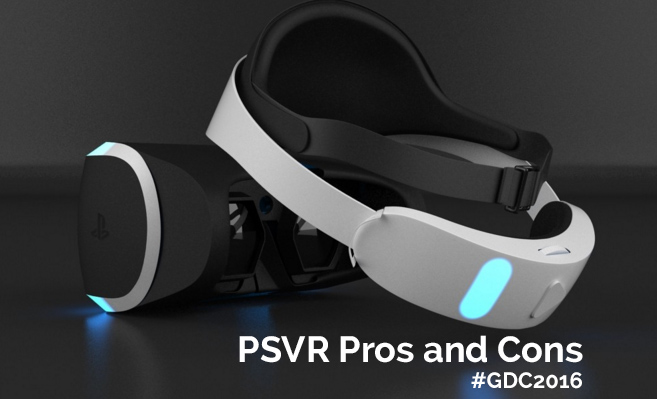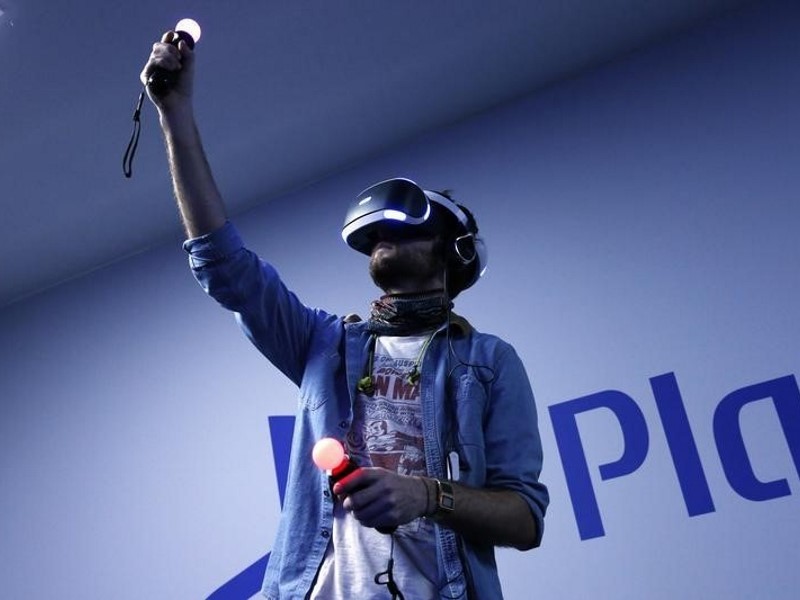Sony’s PlayStation VR [PSVR] headset is an interesting case. Having recently received a demo of the device it’s clear that it can’t be easily ranked against its peers in the high-end VR space, the Oculus Rift and the HTC Vive. A lot of this has to do with display tech.
Solving for the “Screen Door Effect”
With less per-eye resolution than the other two (1080×1200 for Rift and Vive, 960×1080 for PSVR), the displayed imagery is noticeably less crisp than that of the Vive or Rift. That said, Sony has somehow solved the issue of the dreaded “screen-door effect” almost completely. For those not familiar with this common gripe about current generation VR headsets, the screen-door effect refers to the visible black space between the pixel elements that make up the images in a head-mounted display [HMD]. Others have attempted to mitigate the effect by arranging screen pixels in non-grid patterns such as the pentile pattern employed by Oculus and HTC. How Sony has managed to implement a nearly continuous tone display is something of a mystery – especially given the lower resolution – but they have, and it is good. The softness however, remains. It’s hard not to think about how amazing the crisper displays of Vive and Rift would look without the screen-door artifacting, and I’m sure they’re both working on it.
Refresh Rate
The other place where Sony seems to be way ahead of the crowd is in refresh rate. Often mistakenly tied to frame rate (more on that later), refresh rate refers to the time a single pixel takes to change state when fed a new frame. Low refresh rates cause subtle smearing when objects traverse the screen, which is particularly problematic in VR, since every move of one’s head will cause their entire world to traverse and smear. This results in quicker HMD fatigue in the best cases and disorientation and nausea in the worst. The PSVR displays feature a refresh rate of 120hz, compared to 90hz for Rift and Vive. The difference is noticeable. My demo was high-energy and frenetic with my head whipping around for about ten minutes – truly a worst-case scenario for refresh rate – and I never experienced the slightest discomfort.
Frame Rate
Frame rate is the other big factor that contributes to (or undermines) one’s sense of immersion in VR. I’ve read several accounts online of PSVR boasting frame rates of 120fps. Rift and Vive encourage a minimum of 90fps, with most of their titles struggling to meet that spec on common hardware. It seems that a lot of people were mistaking refresh rates for frame rates, and when I pressed the demo guys on this point they conceded that their frame rates were “60fps, sometimes 70”. This is interesting, because 90fps is considered an ideal minimum for VR, not just because it seems to largely vanquish nausea, but because at that rate your brain is unable to distinguish individual frames, setting the stage for the unique state of presence that the best implementations of VR can provide.
The Verdict on the PSVR
So PSVR is kind of a mixed technical bag. They seem to have solved nausea and disorientation, period – so long as developers of game titles faithfully adhere to the standard VR best practices. No other HMD can really claim that at this time. That said, I don’t know that true VR presence is possible with PSVRs diminished resolution and frame rate. At no time in my experience was I not aware of both, and I was being attacked by machete-wielding circus clowns, so I should have been well-distracted from minor display issues.
I’m a tough judge, and even given all of the above it was an amazing VR experience – especially given the $399.00 price tag. I doubt I’ll get past Christmas without one of these finding its way into my home.
Clash of the VR Headsets – Comparisons from Around the Web
CNET: How Playstation VR Compares with Oculus Rift Vive
Gadgets 360: Playstation VR vs Oculus Rift vs HTC Vive: What’s the Difference?


